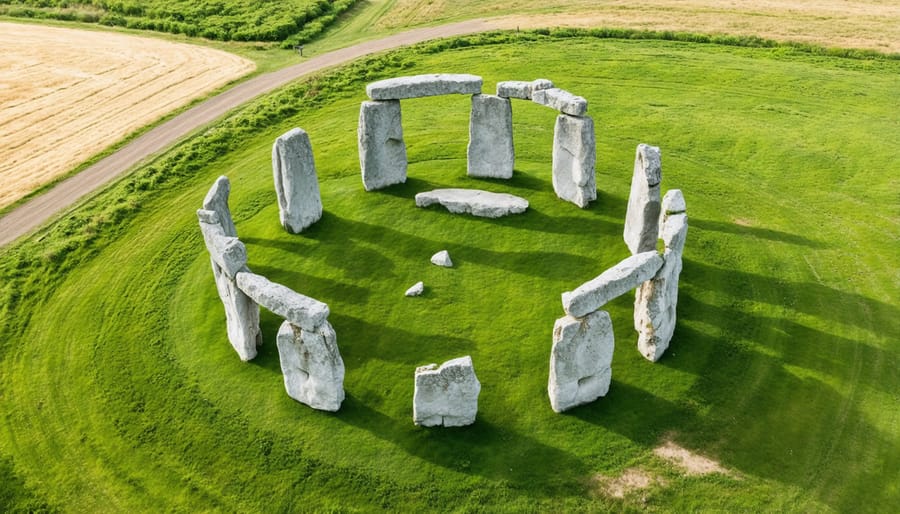Stonehenge stands as one of humanity’s most remarkable achievements in natural stone’s historical significance, serving multiple sophisticated functions that continue to astound researchers and engineers today. Built between 3000-2000 BCE, this ancient marvel functioned as a precise astronomical calendar, religious ceremony center, and sophisticated feat of engineering that demonstrated advanced understanding of mathematics, physics, and construction techniques.
Recent archaeological evidence reveals Stonehenge’s primary role as a sacred burial ground and ceremonial complex, where ancient Britons gathered during crucial solar events like the summer and winter solstices. The monument’s careful alignment with celestial bodies enabled its use as an astronomical observatory, helping ancient peoples track seasonal changes and plan agricultural activities with remarkable accuracy.
The structure’s innovative engineering – featuring massive sarsen stones weighing up to 25 tons, interlocked using sophisticated mortise and tenon joints – demonstrates advanced architectural knowledge that influenced construction techniques for generations. This architectural masterpiece continues to inform modern understanding of stone construction principles, structural stability, and the sophisticated capabilities of ancient builders.
Modern analysis of Stonehenge’s acoustic properties suggests it may have also served as an ancient amphitheater, with its circular arrangement creating unique sound effects that enhanced ceremonial experiences.

The Architectural Marvel of Stonehenge
Stone Selection and Transport
The stones used in Stonehenge’s construction were carefully selected for their specific properties and symbolic significance. Two main types of stone were used: the larger sarsen stones, weighing up to 30 tons each, and the smaller bluestone rocks, weighing between 2 to 5 tons each.
The sarsen stones, composed of extremely hard sandstone, were sourced from the Marlborough Downs, approximately 20 miles north of Stonehenge. These massive stones form the iconic outer circle and trilithons. Their durability and size made them ideal for creating the monument’s primary structural elements.
The bluestones, however, have a more remarkable origin story. These stones were transported from the Preseli Hills in Wales, roughly 150 miles away. Scientific analysis of these rocks reveals they are a mixture of spotted dolerite, rhyolite, and volcanic rocks. The remarkable distance these stones traveled has led to extensive debate about transport methods.
Evidence suggests the builders used a combination of sledges, rollers, and rafts to move these massive stones. They likely transported the Welsh bluestones by water for much of the journey, using the Bristol Channel and local rivers. The final land journey involved dragging the stones on wooden sledges, possibly using timber rollers and leather ropes, with teams of hundreds of people working together.
This extraordinary feat of engineering and determination demonstrates the importance of stone selection in Stonehenge’s construction and the remarkable capabilities of Neolithic builders.
Construction Methods and Technologies
The construction of Stonehenge demonstrates remarkable engineering prowess, employing sophisticated ancient stone construction techniques that continue to astound modern builders. The massive sarsen stones, weighing up to 30 tons each, were carefully shaped using stone hammers and sophisticated mortise-and-tenon joints. These joints, similar to wooden carpentry techniques, allowed the horizontal lintels to lock securely onto the vertical stones.
Archaeological evidence suggests the builders used a combination of wooden platforms, rollers, and ropes to transport the stones. They likely employed a system of temporary timber platforms and levers to raise the vertical stones, gradually tilting them into position while filling the holes with chalk rubble. The horizontal lintels were probably raised using timber platforms built up around the vertical stones.
The smaller bluestones, weighing around 4 tons each, required transportation from Wales, nearly 200 miles away. Recent studies indicate these stones were moved using sledges on wooden rollers, with teams of workers pulling them along established routes. The precision of stone placement demonstrates advanced mathematical and astronomical knowledge, with stones arranged to align with solar and lunar events.
The builders also utilized innovative ground preparation techniques, creating carefully leveled surfaces and digging precise holes with deer antler picks and wooden shovels. This attention to foundation work ensured the monument’s remarkable stability, allowing it to stand for over 4,500 years.

Urban Planning Principles Revealed
Spatial Organization
The spatial organization of Stonehenge reveals sophisticated ancient architectural principles that continue to influence modern design. The monument’s concentric circular layout consists of precisely arranged stone elements, with the outer circle measuring approximately 108 feet in diameter. This primary circle originally comprised 30 upright sarsen stones, topped with horizontal lintels, creating a continuous ring structure.
At the heart of Stonehenge lies the horseshoe formation of five trilithons, massive stone structures arranged in a U-shape opening toward the northeast. This inner arrangement demonstrates careful consideration of sight lines and spatial hierarchy, with the largest trilithon positioned at the center of the horseshoe’s curve.
The builders incorporated astronomical alignments into the design, most notably through the monument’s primary axis, which aligns with the summer solstice sunrise and winter solstice sunset. The entrance pathway, marked by the Heel Stone, creates a ceremonial approach that guides visitors through a carefully orchestrated sequence of spaces.
The spacing between stones follows consistent mathematical relationships, suggesting the use of standardized measurements in ancient Britain. The gaps between the outer circle’s stones are remarkably uniform, while the trilithons’ placement creates balanced negative spaces that frame views through the monument.
This deliberate arrangement of stone elements demonstrates an advanced understanding of spatial relationships, proportion, and visual weight – principles that remain relevant in contemporary architecture and urban planning.

Community Center Design
Recent archaeological evidence suggests that Stonehenge served as a vital community gathering space, functioning much like modern civic centers. The monument’s circular design created a natural amphitheater effect, allowing large groups to congregate while maintaining clear sightlines and acoustic properties that facilitated communication among participants.
The careful arrangement of the stones created distinct spaces for different community activities. The outer circle likely served as a processional route, while the inner horseshoe configuration provided a focal point for ceremonies and gatherings. Archaeological findings of feast remnants, including animal bones and pottery fragments, indicate that Stonehenge hosted large-scale communal meals and celebrations, particularly during the summer and winter solstices.
The monument’s location on Salisbury Plain was strategically chosen, situated at the intersection of several ancient routes. This placement made it accessible to communities from various regions, suggesting it functioned as a centralized meeting point for different groups to gather, trade, and participate in shared cultural practices.
The architectural design demonstrates remarkable social engineering. The massive sarsen stones were arranged to create a sheltered space that could accommodate hundreds of people while maintaining sight lines to astronomical alignments. This dual functionality – serving both practical gathering needs and celestial observation – shows sophisticated planning that modern architects still admire today.
Evidence of temporary settlements around Stonehenge, particularly during significant astronomical events, further supports its role as a community hub. These gatherings would have strengthened social bonds, facilitated cultural exchange, and helped maintain political alliances between different groups across southern Britain.
Legacy in Modern Stone Construction
Durability and Sustainability Lessons
Stonehenge’s remarkable durability, standing strong for over 5,000 years, offers valuable lessons for modern construction and sustainable design. The monument’s longevity demonstrates the effectiveness of several key engineering principles that remain relevant today.
The careful selection and positioning of materials at Stonehenge showcase the importance of material compatibility and structural integrity. The builders chose specific types of stone – sarsen and bluestone – for their durability and weathering resistance. Modern architects and builders apply similar principles when selecting natural stone for construction projects, considering factors like climate exposure and load-bearing requirements.
The monument’s dry-stone construction technique, which eliminates the need for mortar, has proven remarkably sustainable. This method allows for natural thermal expansion and contraction without compromising structural integrity. Contemporary sustainable building practices often incorporate these principles through mechanical fixing systems and ventilated façades.
Stonehenge’s orientation and layout also demonstrate an early understanding of environmental adaptation. The structure’s alignment with solar patterns and its strategic positioning for wind protection offer insights into passive environmental control – a crucial aspect of modern sustainable architecture. Today’s designers increasingly incorporate these ancient principles of natural climate management into energy-efficient building designs.
The monument’s minimal maintenance requirements over millennia highlight the long-term sustainability benefits of proper material selection and construction techniques. While initial costs for quality stone materials may be higher, the reduced lifecycle costs and environmental impact make it a sustainable choice for modern construction.
Perhaps most significantly, Stonehenge demonstrates the potential for buildings to serve multiple functions while maintaining structural integrity. The dual role of the monument as both a ceremonial center and an astronomical calendar parallels modern demands for multifunctional, adaptable spaces that stand the test of time.
These enduring principles from Stonehenge continue to influence contemporary sustainable construction practices, proving that ancient wisdom can inform modern solutions for durable, environmentally conscious architecture.
Monumental Stone in Modern Architecture
The principles that guided Stonehenge’s construction continue to influence modern stone architecture in remarkable ways. Contemporary architects and designers draw inspiration from this ancient monument’s innovative use of massive stone elements, creating structures that blend historical gravitas with modern functionality.
Notable examples include the National Museum of the American Indian in Washington, D.C., where carefully positioned limestone blocks echo Stonehenge’s astronomical alignment principles while serving as natural climate regulators. The museum’s design demonstrates how ancient stone-working techniques can be adapted for sustainable building practices.
In Europe, the Scottish Parliament Building showcases monumental granite panels that pay homage to megalithic construction while incorporating cutting-edge engineering. These massive stone elements not only provide structural integrity but also connect the building to Scotland’s rich geological heritage.
The Getty Center in Los Angeles exemplifies how traditional stone-working methods can be reimagined through modern technology. Its travertine cladding, precisely cut using computer-controlled machinery, creates a visual impact reminiscent of Stonehenge’s imposing presence while meeting contemporary performance standards.
Urban planners increasingly incorporate standing stones and circular arrangements in public spaces, drawing on Stonehenge’s principles of spatial organization. These installations serve as gathering points and solar calendars, much like their ancient predecessor, while adding cultural significance to modern cityscapes.
Recent technological advances have enabled architects to push the boundaries of stone construction further than ever before. Using parametric design and advanced engineering, contemporary buildings feature seemingly impossible stone configurations that would have amazed even Stonehenge’s builders. These innovations include ultra-thin stone veneers, cantilever designs, and self-supporting stone structures that challenge traditional limitations.
The enduring influence of Stonehenge proves that monumental stone construction remains relevant in addressing modern architectural challenges, from sustainability to cultural expression. As we continue to develop new technologies and techniques, the fundamental principles of this ancient wonder guide us toward innovative solutions in contemporary building design.
Stonehenge’s influence on construction and urban development extends far beyond its original purpose, establishing fundamental principles that continue to shape our built environment today. The monument’s sophisticated understanding of structural integrity, load distribution, and material durability has influenced countless architectural projects throughout history.
The ingenious use of interlocking stones and precise astronomical alignment demonstrated at Stonehenge laid the groundwork for advanced construction techniques. Modern architects and engineers still draw inspiration from these ancient methods, particularly in sustainable design and the strategic use of natural materials. The monument’s circular layout and consideration of human movement patterns have influenced contemporary urban planning, especially in the design of public spaces and ceremonial centers.
Perhaps most significantly, Stonehenge revolutionized our understanding of stone as a construction material. Its builders’ mastery of megalithic architecture proved that stone could be used not just for shelter, but as a means of creating lasting monuments that serve both practical and cultural purposes. This legacy continues to influence modern stone construction, from the creation of civic buildings to the design of public memorials.
Today, Stonehenge stands as a testament to human ingenuity and serves as a constant reminder that thoughtful construction and urban planning can create structures that endure for millennia. Its principles of durability, functionality, and cultural significance remain relevant in contemporary architecture and continue to inspire innovations in stone construction techniques.










